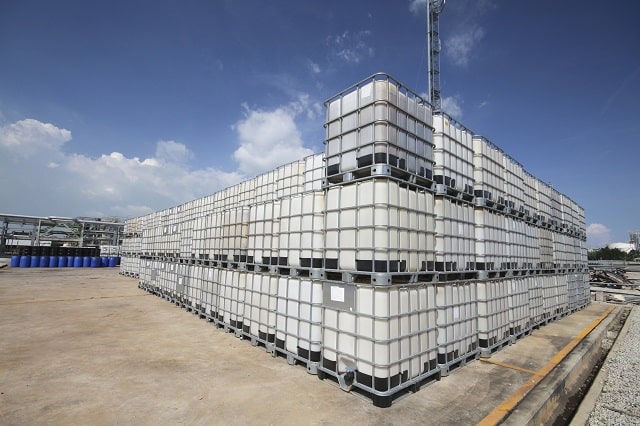Intermediate Bulk Containers (IBCs), also called totes, are a storage container design that is used to transport materials at high volume. The volume of an IBC is generally between 275 and 330 gallons, which sits between larger bulk containers and 55-gallon drums. Totes are typically comprised of metal, plastic, or fabric, based upon the materials they contain. They can be costly due to their large size.
In this post, we’ll discuss 5 ways a tracking system can help control the costs associated with the procurement, usage, and upkeep of intermediate bulk containers. Many IBC configurations are reusable and an important asset for fleet managers working to move materials efficiently. An asset tracking system, such as an Enterprise Asset Management (EAM) platform coupled with durable nameplates or barcode labels, can be used to centralize important IBC information and manage all critical tasks associated with each container’s usage.

A tracking system allows a dispersed team to view and track the status of each IBC from anywhere in the world. Most software programs also include a detailed and secure chain of custody that can also be used during audits. This helps companies reduce the potential for regulatory fines and helps maintain a compliant work environment for all totes that are in service. This chain of custody can also be used by supply chain partners for complete transparency at every point in the logistics loop for returnable IBC assets.
Since IBC tracking systems use automated and semi-automated processes, they are extremely reliable. Barcode labels and RFID tags can be scanned whenever an IBC enters or leaves a facility providing reliable tracking for its location. Some tracking technologies can also provide real-time geolocation data for totes that are carrying particularly valuable materials or materials that require a greater level of oversight.
Companies can use this location data to identify IBCs that have been sitting empty at customer sites and request that they be returned. This helps reduce costs and losses related to underutilized assets. The returned containers can then be filled and shipped again for increased sales.

An IBC, like any piece of equipment, should be properly maintained to ensure a proper working condition. An asset management system can be used not only to track assets but also to optimize maintenance work and develop clear procedures. Each IBC can also be assigned an owner and have specific instructions attached to avoid any confusion among staff. These clear responsibilities and assignments are an excellent way to extend asset life and find greater efficiencies from your IBC operation.
IBC tracking systems contain much more information than just location data. Since these totes are filled with specific materials prior to shipment and use, the tracking platform can be used to record data such as lot information, IBC configurations, storage conditions, and maintenance histories. Having this information in a centralized location has several benefits for staff and management.
When an IBC arrives at a new location, it can be scanned to quickly retrieve any relevant information in seconds. This can greatly improve the speed at which IBCs can be processed and lead to greater cost savings from operations. Detailed equipment records also help improve safety by reducing the likelihood of compatibility issues or degradation of materials from improper storage conditions. An IBC tracking system can also be used to generate automated packing lists, safety data sheets, and other documentation for simplified packing and shipping.
Another way IBC tracking systems can help control costs is by improving container utilization. When containers sit idle, they are not able to fulfill their role in transporting goods between locations. If many IBCs are underutilized, it can put a strain on the procurement department to acquire new totes to keep up with existing product demand. The goal of an IBC loop is to deliver the most material with the fewest number of containers.
An IBC tracking system makes it easier to set optimal inventory stock levels at factories, warehouses, and customer locations. These systems also provide real-time visibility for adverse events such as damaged shipments or returned products. This information allows fleet managers to make adjustments quickly to ensure a stable supply of material with lower additional costs.
Bulk containers are a costly but worthwhile investment for materials suppliers and logistics partners who need to transport materials in large quantities. Efficient use of these IBC fleets helps ensure that product margins are optimized while reducing the costs of delivery and storage. The 5 cost efficiencies presented in this post help demonstrate the value of using a dedicated tracking system for the management of these important assets.
Our sales engineers are experts in automatic asset tracking, tagging and identification,a nd can answer all your questions. Get in touch now.
Lets Talk ›